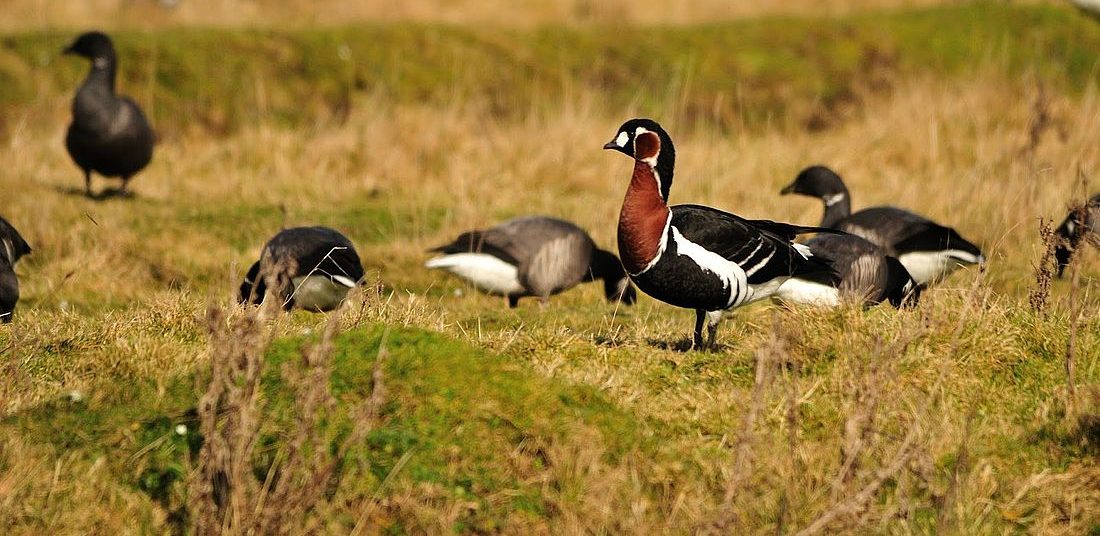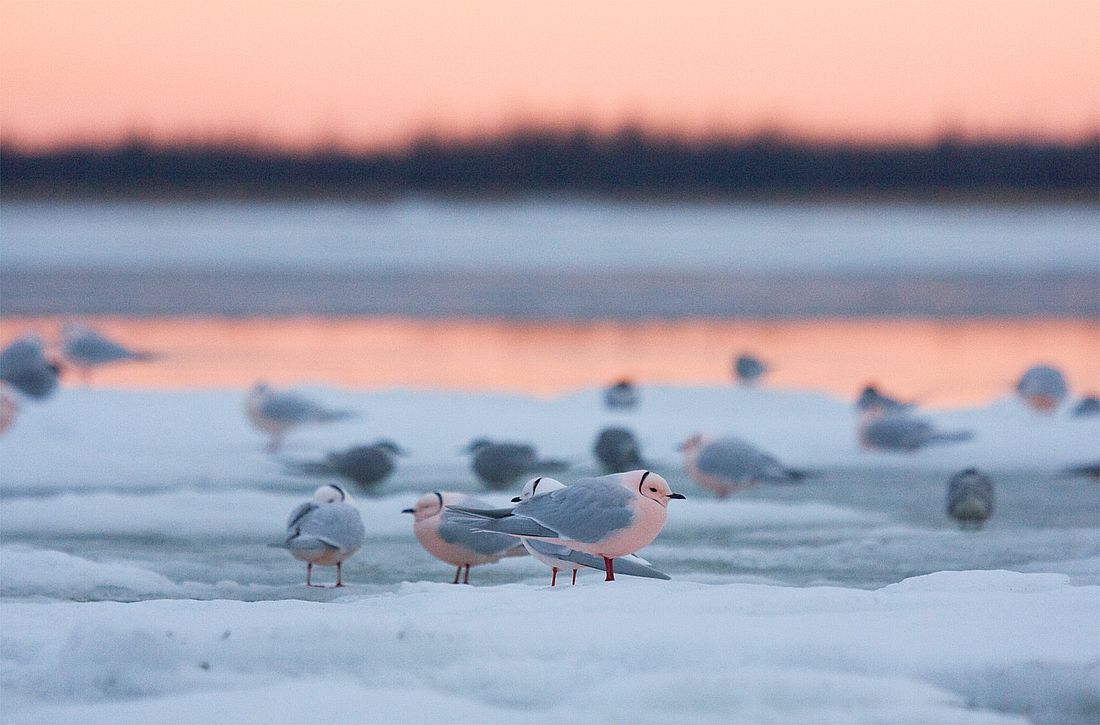Living on Taimyr for many years, you get used to its flora and fauna. Many of us do not even know that in our territory there are animals, birds, insects, plants that are not found anywhere else in the world.
1. The White-billed (white-nosed) polar loon. The largest of the five known species of loons: its weight reaches 6.4 kilograms, length – 75–100 centimeters, its wingspan reaches 135–155 centimeters. This species is characterized by a sporadic distribution, therefore, the areal is not a single whole, but a chain of separate areas inhabited by these birds.
White-billed loons live in the tundra along the coastline near fresh and salt water, because they prefer to fish in shallow water and nest there. The presence of fish-rich reservoirs is the main condition for nesting. White-billed loons are daytime predators: they hunt fish, swim, dive and fly during the day, until sunset. Despite the fact that they catch most of their food near the surface of the water, large individuals can dive to a depth of 20–50 meters. They are able to stay under water for about eight minutes. A pair of white loons, along with young offspring, eat up to 900 kilograms of fish during the breeding season. Birds also ingest pebbles regularly to aid their digestive system.
2. The Red-breasted goose. Another rare species, endemic to Russia. In the middle of the twentieth century, the number of the species decreased to 6.5 thousand, thanks to the inclusion in the Red Book, the population grew to 35 thousand individuals.
Due to their unusual coloration, these birds are considered one of the most beautiful representatives of the goose. The nesting area covers the southern part of the arctic tundra, typical and shrub tundra. Red-breasted geese mate for life. To protect the offspring, they nest next to falcons and buzzards: feathered predators drive away gulls and foxes and warn of danger. The red-breasted goose is depicted on the Taimyr coat of arms.
3. The Small or tundra swan. This bird is a smaller copy of another whooper swan that lives in the same places in the tundra. The smallest of all swans has a body length of 115–127 centimeters, a wingspan of 170–195 centimeters, and a weight of 5–6 kilograms. The nesting area in the Taimyr peninsula includes typical and shrub tundra. However, tundra swans spend only 120–130 days a year at their nesting sites, the rest of the time is spent on migration and wintering.
The small swan is very sensitive to the presence of humans; therefore, the species has practically disappeared from the areas of the tundra most developed by people. However, wintering in crowded places makes swans more tolerant of human presence. There is information that individual pairs of small swans are already nesting near northern villages. Commercial hunting for small swans is not conducted now, but poaching for meat, down and feathers, unfortunately, happens quite often.
4. The Peregrine falcon. The Taimyr tundra is inhabited by the largest of the Palearctic peregrine falcon species – the tundra, or barnacle falcon. The nesting area covers almost the entire tundra zone. Peregrine falcon is a predator, it hunts birds of medium and small sizes: sparrows, pigeons, ducks. In addition to birds, its diet includes small mammals such as lemmings, squirrels and hares, as well as amphibians and insects.
Peregrine falcons hunt in the morning and evening, often in pairs. They are formidable predators. The peregrine falcon can lie in ambush for a long time, sit on a high ledge or fly low above the ground to scare away the victim. Having spotted prey, the bird gains height with lightning speed, folds its wings and dives vertically downward. During such a flight, the speed of the peregrine falcon reaches 322 kilometers per hour, or 90 meters per second, thanks to which this bird has earned the title of the fastest living organism in the world. The blow on the victim is so strong that the head flies off or the body is ripped apart along its entire length. If the force of the blow does not kill the victim, then the falcon breaks its neck with its beak.
5. The Ross’s gull. A poorly studied species, endemic to Russia, included in the Red Book of the Russian Federation. On Taimyr, only one nesting colony of these 45–50 bird pairs is known in Eastern Taimyr, in the area of the Bolshaya Balakhnya river. They breed in lacustrine-boggy lowlands in small sparse colonies or in separate pairs.
The Ross’s gull is an amazingly graceful and spectacular bird, especially in flight, as it flies easily and silently, as if floating through the air. Its body length is 35 centimeters on average, and its wingspan is 84 centimeters. Among the peoples of the North and Arctic travelers, it is believed that meeting a Ross’s gull brings good luck and happiness.
6. The Ivory gull. Breeds on Kara Sea islands: Severnaya Zemlya archipelago, Diabazov, Sedov, Paris Commune, Solitude islands. It does not nest on the mainland, but it flies regularly to the Arctic coast of Taimyr. It got its name due its appearance, which serves as an excellent camouflage in the snow. In the conditions of the snowy Arctic, ivory gulls can only be seen due to a beautiful yellow-blue beak and black paws. But it is more difficult for young gulls to hide in the snow – up to two years old, their white plumage is covered with black dots.
Ivory gulls do not observe “migration laws” – this is the only species of Arctic birds that does not fly south with the onset of winter, but remains within the Arctic Ocean all year round. These birds are nomads, but move just within the Arctic islands. The colonies unite only in spring to prepare for the summer breeding season. They arrange their nests on sheer coastal rocks: they line small depressions with moss, algae and lichen. Other popular breeding dwellings are ice depressions. Such ice nests are reliably protected from predators such as arctic fox. Ivory gulls often gravitate towards human habitation and hunting grounds for sea animals, where it is easier for them to find food.
7. The White-tailed eagle. One of the four large representatives of birds of prey: body length reaches 90 centimeters, weight – 7 kilograms, and wingspan – 230 centimeters. The White-tailed eagle’s nests are quite impressive in size – two meters in diameter and up to one meter deep. The eagle settles near reservoirs that are abundant in fish (it makes up the main diet), and as far as possible from people. In winter, eagles hunt mainly hares. Solitary birds annually fly far into the tundra, up to the Arctic coast of Taimyr.
Due to its impressive size, powerful beak and claws, the white-tailed eagle has no natural enemies in nature. But this is only true for adult birds. Chicks and eggs are often attacked by predators such as bears. Man became another enemy for the eagle population. In the middle of the twentieth century, people decided that the eagle consumes too much fish and destroys the valuable muskrat. So people decided to shoot the eagle, that led to a large reduction in the population of this species. In 2013, the Russian Bird Conservation Union chose the white-tailed eagle as bird of the year to draw people’s attention to the problems of preserving this bird of prey.
We have listed the “inhabitants” only of the Red Book of Russia. There is a similar edition that protects our nature in the Krasnoyarsk region. In it, the list of birds protected by law is wider. For example, it includes the American goose, lesser white-fronted goose, western tundra bean goose, kloktun, gyrfalcon, chrustan, ruby-necked sandpiper, sea, Icelandic and pointed-tailed sandpipers, gerbils, mud-tails and other birds.
In previous publications of the Facts and numbers series, we talked about the Taimyr Red Book plants, the Norilsk weather, the indigenous peoples of Taimyr and other interesting facts and details.
Text: Olga Polyanskaya, Maria Sokolova, Photo: open sources










